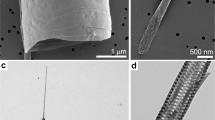Abstract
The cell walls of diatoms consist of a silica frustule encased in an organic coating. Biochemical characterization of this coating should allow insight into: (1) the mechanism of silicification; (2) taxonomy and evolution of diatoms; (3) preservation of fossil frustules. The amino acid and sugar composition of cell walls from 6 diatom species have been elucidated. When compared to cellular protein, cell-wall protein is enriched in serine plus threonine and glycine, and depleted in acidic, sulfur-containing and aromatic amino acids. The sugars of the cell-wall carbohydrates are quite variable and fucose tends to replace glucose in estuarine species. Condensation of silicic acid, in epitaxial order, on a protein template enriched in serine and threonine, is suggested as the Si-depositing mechanism in diatoms. The nature of this template and the polysaccharides in the cell wall may determine the solubility of diatom frustules in various environments. There is sufficient variability in cell-wall amino acids to warrant further investigation of their taxonomic utility. The sugars appear to be related to environmental factors, but they may also serve in biosystematic studies.
Similar content being viewed by others
Literature Cited
Calvert, S. E.: Silica balance in the ocean and diagenesis. Nature, Lond. 219, 919–920 (1968).
Coombs, J. and B. E. Volcani: Studies on the biochemistry and fine structure of silica shell formation in diatoms. Chemical changes in the wall of Navicula pelliculosa during its formation. Planta 82, 280–292 (1968).
Degens, E. T. and J. Matheja: Formation of organic polymers on minerals and vice versa. In: Organic compounds in aquatic environments, pp 29–39. Ed. by S. J. Faust and J. V. Hunter, New York: Dekker 1971.
Degens, E. T. and D. W. Spencer: Data file on amino acid distribution in calcified and uncalcified tissues of shell forming organisms, 32 pp. Unpublished m/s. Woods Hole Oceanographic Institution 1966.
— and R. H. Parker: Paleobiochemistry of molluscan shell proteins. Comp. Biochem. Physiol. 20, 553–579 (1967).
Fowden, L.: Amino acids and proteins. In: Physiology and biochemistry of algae, pp 189–209. Ed. by R. A. Lewin. New York: Academic Press 1962.
Gotelli, I. B. and R. Cleland: Differences in the occurrence and distribution of hydroxyproline-proteins among the algae. Am. J. Bot. 55, 907–914 (1968).
Guillard, R. R. L. and C. J. Lorenzen: Yellow-green algae with chlorophyllide c. J. Phycol. 8, 10–14 (1972).
— and J. H. Ryther: Studies of marine planktonic diatoms. I. Cyclotella nana Hustedt and Dentonula confervacea (Cleve) Gran. Can. J. Microbiol. 8, 229–239 (1962).
Handa, N.: Carbohydrate metabolism in the marine diatom Skeletonema costatum. Mar. Biol. 4, 208–214 (1969).
Kamatani, A.: Physical and chemical characteristics of biogenous silica. Mar. Biol. 8, 89–95 (1971).
Kates, M. and B. E. Volcani: Studies on the biochemistry and fine structure of silica shell formation in diatoms. Lipid components of the cell walls. Z. PffPhysiol. 60, 19–29 (1968).
King, K., Jr., and P. E. Hare: Amino acid composition of planktonic foraminifera: a paleobiochemical approach to evolution. Science, N.Y. 175 1461–1463 (1972).
Kreger, D. R.: Cell walls. In: Physiology and biochemistry of algae, pp 315–335. Ed. by R. A. Lewin New York: Academic Press 1962.
Lamport, D. T. A.: The protein component of primary cell walls. Adv. bot. Res. 2, 151–213 (1965).
— and D. H. Miller: Hydroxyproline arabinosides in the plant kingdom. Pl. Physiol., Wash. 48, 454–456 (1971).
Lewin, J. C.: The dissolution of silica from diatom cell walls. Geochim. cosmochim. Acta 21, 182–189 (1961).
— Silicification. In: Physiology and biochemistry of algae, pp 445–455. Ed. by R. A. Lewin. New York: Academic Press 1962.
Lisitzin, A. P.: Distribution of siliceous microfossils in suspension and in bottom sediments In: The micropaleontology of oceans, pp 173–196. Ed. by B. M. Funnel and W. R. Riedel. Cambridge: University Press 1971.
Matheja, J. and E. T. Degens: Functions of amino acid side chains. Adv. Enzymol. 34, 1–39, (1971a).
— Structural molecular biology of phosphates, 180 pp. Stuttgart: Fischer 1971b.
Meeuse, B. J. D.: Storage products. In: Physiology and biochemistry of algae, pp 289–313. Ed. by R. A.,Lewin. New York: Academic Press 1962.
Miller, D. H., D. T. A. Lamport and M. Miller: Hydroxyproline heterooligosaccharides in Chlamydamonas. Science, N.Y. 176, 918–920 (1972).
Mopper, K. and E. T. Degens: Amino acids and sugars in sediment, plankton and sewage: analytical methods and data file. Unpublished manuscript, Woods Hole Oceanographic Institution 1972a.
— A new chromatographic sugar analyzer with a sensitivity of 10−10 moles. Analyt. Biochem. 45, 147–153 (1972b).
Nakajima, T. and B. E. Volcani 3,4-dihydroxyproline: a new amino acid in diatom cell walls. Science, N.Y. 164, 1400–1402 (1969).
Percival E. and R. H. MacDowell: Chemistry and enzymology of marine algal polysaccharides, 219 pp New York Academic Press 1967.
Reimann, B. E. F., J. C. Lewin and B. E. Volcani: Studies on the biochemistry and fine structure of silica shell formation in diatoms. I. The structure of the cell wall of Cylindrotheca fusiformis Reimann and Lewin. J. Cell Biol. 24, 39–55 (1965).
—: Studies on the biochemistry and fine structure of silica shell formation in diatoms. II. The structure of the cell wall of Navicula, pelliculosa (Bréb.) Hilse. J. Phycol. 2, 74–84 (1966).
Author information
Authors and Affiliations
Additional information
Communicated by J. Bunt, Miami
Contribution No. 2928 from the Woods Hole Oceanographic Institution. This work was supported by a Woods Hole Oceanographic Institution Postdoctoral Fellowship to R. E. Hecky, a National Science Foundation Postdoctoral Fellowship to P. Kilham, and a Woods Hole Oceanographic Institution Fellowship to K. Mopper.
Rights and permissions
About this article
Cite this article
Hecky, R.E., Mopper, K., Kilham, P. et al. The amino acid and sugar composition of diatom cell-walls. Marine Biology 19, 323–331 (1973). https://doi.org/10.1007/BF00348902
Accepted:
Issue Date:
DOI: https://doi.org/10.1007/BF00348902




